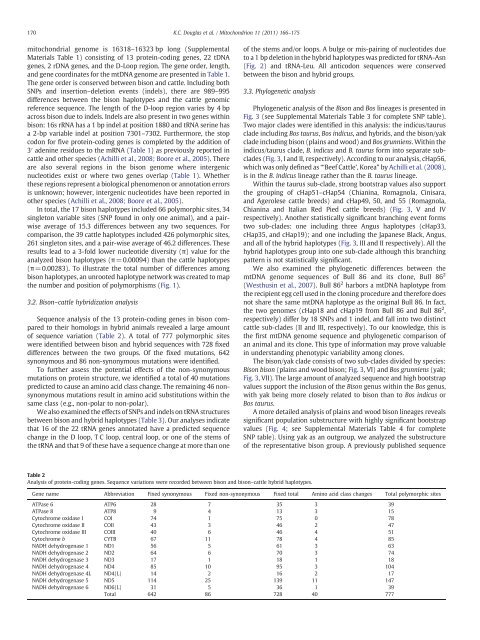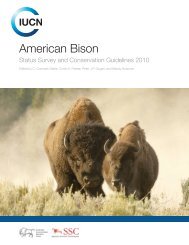Complete mitochondrial DNA sequence analysis of Bison bison and ...
Complete mitochondrial DNA sequence analysis of Bison bison and ...
Complete mitochondrial DNA sequence analysis of Bison bison and ...
You also want an ePaper? Increase the reach of your titles
YUMPU automatically turns print PDFs into web optimized ePapers that Google loves.
170 K.C. Douglas et al. / Mitochondrion 11 (2011) 166–175<br />
<strong>mitochondrial</strong> genome is 16318–16323 bp long (Supplemental<br />
Materials Table 1) consisting <strong>of</strong> 13 protein-coding genes, 22 t<strong>DNA</strong><br />
genes, 2 r<strong>DNA</strong> genes, <strong>and</strong> the D-Loop region. The gene order, length,<br />
<strong>and</strong> gene coordinates for the mt<strong>DNA</strong> genome are presented in Table 1.<br />
The gene order is conserved between <strong>bison</strong> <strong>and</strong> cattle. Including both<br />
SNPs <strong>and</strong> insertion–deletion events (indels), there are 989–995<br />
differences between the <strong>bison</strong> haplotypes <strong>and</strong> the cattle genomic<br />
reference <strong>sequence</strong>. The length <strong>of</strong> the D-loop region varies by 4 bp<br />
across <strong>bison</strong> due to indels. Indels are also present in two genes within<br />
<strong>bison</strong>: 16s rRNA has a 1 bp indel at position 1880 <strong>and</strong> tRNA serine has<br />
a 2-bp variable indel at position 7301–7302. Furthermore, the stop<br />
codon for five protein-coding genes is completed by the addition <strong>of</strong><br />
3′ adenine residues to the mRNA (Table 1) as previously reported in<br />
cattle <strong>and</strong> other species (Achilli et al., 2008; Boore et al., 2005). There<br />
are also several regions in the <strong>bison</strong> genome where intergenic<br />
nucleotides exist or where two genes overlap (Table 1). Whether<br />
these regions represent a biological phenomenon or annotation errors<br />
is unknown; however, intergenic nucleotides have been reported in<br />
other species (Achilli et al., 2008; Boore et al., 2005).<br />
In total, the 17 <strong>bison</strong> haplotypes included 66 polymorphic sites, 34<br />
singleton variable sites (SNP found in only one animal), <strong>and</strong> a pairwise<br />
average <strong>of</strong> 15.3 differences between any two <strong>sequence</strong>s. For<br />
comparison, the 39 cattle haplotypes included 426 polymorphic sites,<br />
261 singleton sites, <strong>and</strong> a pair-wise average <strong>of</strong> 46.2 differences. These<br />
results lead to a 3-fold lower nucleotide diversity (π) value for the<br />
analyzed <strong>bison</strong> haplotypes (π=0.00094) than the cattle haplotypes<br />
(π=0.00283). To illustrate the total number <strong>of</strong> differences among<br />
<strong>bison</strong> haplotypes, an unrooted haplotype network was created to map<br />
the number <strong>and</strong> position <strong>of</strong> polymorphisms (Fig. 1).<br />
3.2. <strong>Bison</strong>–cattle hybridization <strong>analysis</strong><br />
Sequence <strong>analysis</strong> <strong>of</strong> the 13 protein-coding genes in <strong>bison</strong> compared<br />
to their homologs in hybrid animals revealed a large amount<br />
<strong>of</strong> <strong>sequence</strong> variation (Table 2). A total <strong>of</strong> 777 polymorphic sites<br />
were identified between <strong>bison</strong> <strong>and</strong> hybrid <strong>sequence</strong>s with 728 fixed<br />
differences between the two groups. Of the fixed mutations, 642<br />
synonymous <strong>and</strong> 86 non-synonymous mutations were identified.<br />
To further assess the potential effects <strong>of</strong> the non-synonymous<br />
mutations on protein structure, we identified a total <strong>of</strong> 40 mutations<br />
predicted to cause an amino acid class change. The remaining 46 nonsynonymous<br />
mutations result in amino acid substitutions within the<br />
same class (e.g., non-polar to non-polar).<br />
We also examined the effects <strong>of</strong> SNPs <strong>and</strong> indels on tRNA structures<br />
between <strong>bison</strong> <strong>and</strong> hybrid haplotypes (Table 3). Our analyses indicate<br />
that 16 <strong>of</strong> the 22 tRNA genes annotated have a predicted <strong>sequence</strong><br />
change in the D loop, T C loop, central loop, or one <strong>of</strong> the stems <strong>of</strong><br />
the tRNA <strong>and</strong> that 9 <strong>of</strong> these have a <strong>sequence</strong> change at more than one<br />
<strong>of</strong> the stems <strong>and</strong>/or loops. A bulge or mis-pairing <strong>of</strong> nucleotides due<br />
to a 1 bp deletion in the hybrid haplotypes was predicted for tRNA-Asn<br />
(Fig. 2) <strong>and</strong> tRNA-Leu. All anticodon <strong>sequence</strong>s were conserved<br />
between the <strong>bison</strong> <strong>and</strong> hybrid groups.<br />
3.3. Phylogenetic <strong>analysis</strong><br />
Table 2<br />
Analysis <strong>of</strong> protein-coding genes. Sequence variations were recorded between <strong>bison</strong> <strong>and</strong> <strong>bison</strong>–cattle hybrid haplotypes.<br />
Phylogenetic <strong>analysis</strong> <strong>of</strong> the <strong>Bison</strong> <strong>and</strong> Bos lineages is presented in<br />
Fig. 3 (see Supplemental Materials Table 3 for complete SNP table).<br />
Two major clades were identified in this <strong>analysis</strong>: the indicus/taurus<br />
clade including Bos taurus, Bos indicus, <strong>and</strong> hybrids, <strong>and</strong> the <strong>bison</strong>/yak<br />
clade including <strong>bison</strong> (plains <strong>and</strong> wood) <strong>and</strong> Bos grunniens. Within the<br />
indicus/taurus clade, B. indicus <strong>and</strong> B. taurus form into separate subclades<br />
(Fig. 3, I <strong>and</strong> II, respectively). According to our <strong>analysis</strong>, cHap56,<br />
which was only defined as “‘Beef Cattle’, Korea” by Achilli et al. (2008),<br />
is in the B. indicus lineage rather than the B. taurus lineage.<br />
Within the taurus sub-clade, strong bootstrap values also support<br />
the grouping <strong>of</strong> cHap51–cHap54 (Chianina, Romagnola, Cinisara,<br />
<strong>and</strong> Agerolese cattle breeds) <strong>and</strong> cHap49, 50, <strong>and</strong> 55 (Romagnola,<br />
Chianina <strong>and</strong> Italian Red Pied cattle breeds) (Fig. 3, V <strong>and</strong> IV<br />
respectively). Another statistically significant branching event forms<br />
two sub-clades: one including three Angus haplotypes (cHap33,<br />
cHap35, <strong>and</strong> cHap19); <strong>and</strong> one including the Japanese Black, Angus,<br />
<strong>and</strong> all <strong>of</strong> the hybrid haplotypes (Fig. 3, III <strong>and</strong> II respectively). All the<br />
hybrid haplotypes group into one sub-clade although this branching<br />
pattern is not statistically significant.<br />
We also examined the phylogenetic differences between the<br />
mt<strong>DNA</strong> genome <strong>sequence</strong>s <strong>of</strong> Bull 86 <strong>and</strong> its clone, Bull 86 2<br />
(Westhusin et al., 2007). Bull 86 2 harbors a mt<strong>DNA</strong> haplotype from<br />
the recipient egg cell used in the cloning procedure <strong>and</strong> therefore does<br />
not share the same mt<strong>DNA</strong> haplotype as the original Bull 86. In fact,<br />
the two genomes (cHap18 <strong>and</strong> cHap19 from Bull 86 <strong>and</strong> Bull 86 2 ,<br />
respectively) differ by 18 SNPs <strong>and</strong> 1 indel, <strong>and</strong> fall into two distinct<br />
cattle sub-clades (II <strong>and</strong> III, respectively). To our knowledge, this is<br />
the first mt<strong>DNA</strong> genome <strong>sequence</strong> <strong>and</strong> phylogenetic comparison <strong>of</strong><br />
an animal <strong>and</strong> its clone. This type <strong>of</strong> information may prove valuable<br />
in underst<strong>and</strong>ing phenotypic variability among clones.<br />
The <strong>bison</strong>/yak clade consists <strong>of</strong> two sub-clades divided by species:<br />
<strong>Bison</strong> <strong>bison</strong> (plains <strong>and</strong> wood <strong>bison</strong>; Fig. 3, VI) <strong>and</strong> Bos grunniens (yak;<br />
Fig. 3, VII). The large amount <strong>of</strong> analyzed <strong>sequence</strong> <strong>and</strong> high bootstrap<br />
values support the inclusion <strong>of</strong> the <strong>Bison</strong> genus within the Bos genus,<br />
with yak being more closely related to <strong>bison</strong> than to Bos indicus or<br />
Bos taurus.<br />
A more detailed <strong>analysis</strong> <strong>of</strong> plains <strong>and</strong> wood <strong>bison</strong> lineages reveals<br />
significant population substructure with highly significant bootstrap<br />
values (Fig. 4; see Supplemental Materials Table 4 for complete<br />
SNP table). Using yak as an outgroup, we analyzed the substructure<br />
<strong>of</strong> the representative <strong>bison</strong> group. A previously published <strong>sequence</strong><br />
Gene name Abbreviation Fixed synonymous Fixed non-synonymous Fixed total Amino acid class changes Total polymorphic sites<br />
ATPase 6 ATP6 28 7 35 3 39<br />
ATPase 8 ATP8 9 4 13 3 15<br />
Cytochrome oxidase I COI 74 1 75 0 78<br />
Cytochrome oxidase II COII 43 3 46 2 47<br />
Cytochrome oxidase III COIII 40 6 46 4 51<br />
Cytochrome b CYTB 67 11 78 4 85<br />
NADH dehydrogenase 1 ND1 56 5 61 3 63<br />
NADH dehydrogenase 2 ND2 64 6 70 3 74<br />
NADH dehydrogenase 3 ND3 17 1 18 1 18<br />
NADH dehydrogenase 4 ND4 85 10 95 3 104<br />
NADH dehydrogenase 4L ND4(L) 14 2 16 2 17<br />
NADH dehydrogenase 5 ND5 114 25 139 11 147<br />
NADH dehydrogenase 6 ND6(L) 31 5 36 1 39<br />
Total 642 86 728 40 777










